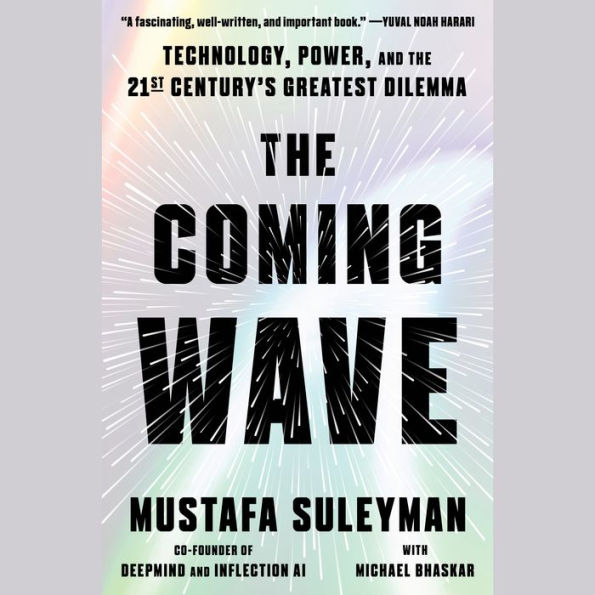Publishers Weekly
07/31/2023
“An emerging cluster of related technologies centered on AI and synthetic biology... will both empower humankind and present unprecedented new risks,” according to this shrewd debut. Suleyman, cofounder of the artificial intelligence companies DeepMind and Inflection AI, chronicles the technological advances that led to today’s AI boom with anecdotes from his career, describing DeepMind’s 2012 work on an algorithm capable of teaching itself simple computer games and the company’s 2018 breakthrough developing a program capable of predicting unknown protein structures. According to Suleyman, four features distinguish these new technologies: the high speed at which they’re developing, the broad variety of uses for them, their ability to function relatively autonomously, and their capacity to affect “entire societies” (he mentions the possibility that “a single system could control autonomous vehicles throughout a territory”). Regulation is the key to dodging dystopia, he contends, outlining 10 steps for keeping AI under human control, including ensuring that all AI have a “bulletproof off switch” and requiring government-issued licenses to produce “the most sophisticated AI systems.” Suleyman’s account of DeepMind’s achievements can come across as self-serving, but anecdotes about other companies working on technologies capable of, for instance, interfacing directly with the human brain, underscore the mind-bending possibilities. It’s a sober take on navigating the perils of AI. (Sept.)
From the Publisher
A heartfelt and candid exploration of what the future may hold for us . . . Eloquently articulated. Reading [The Coming Wave], what came to mind was Gramsci’s famous adage that what we need is ‘pessimism of the intellect, optimism of the will.’ To his great credit, [Mustafa] Suleyman has both.”—The Guardian
“[A] sweeping look at the future of artificial intelligence and other transformative technologies . . . [Mustafa] Suleyman is intimately familiar with the technologies, companies and personalities at the heart of the A.I. revolution.”—The New York Times
“Dazzling . . . You have by now read a great deal of both hype and doom-mongering on the subject [of AI]. But Suleyman’s is the book you cannot afford not to read. . . . Brilliant.”—Niall Ferguson, Bloomberg
“Brilliant . . . confronts what may be the most crucial question of our century: How can we ensure that the breathtaking, fast-paced technological revolutions ahead create the world we want?”—Eric Lander, founding director, Broad Institute of MIT and Harvard
“An erudite, clear-eyed guide both to the history of radical technological change and to the deep political challenges that lie ahead.”—Anne Applebaum, Pulitzer Prize–winning historian
“Extraordinary . . . utterly unmissable.”—Eric Schmidt, former CEO, Google
“Calm, pragmatic, and deeply ethical . . . enthralling reading.”—Angela Kane, former UN under-secretary-general
“Sharp, compassionate, and uncompromising.”—Qi Lu, former COO, Baidu; former EVP, Microsoft Bing
“Truly remarkable, ambitious, and impossible to ignore . . . a persuasively argued tour de force.”—Nouriel Roubini, professor emeritus, New York University
“A practical and optimistic road map.”—Stuart Russell, professor of computer science, University of California, Berkeley
“A panoramic survey and a clarion call to action . . . Everyone should read it.”—Fei-Fei Li, co-director, Stanford’s Institute for Human-Centered AI
“A brave wake-up call . . . indispensable reading.”—Tristan Harris, co-founder, Center for Humane Technology
“An extraordinary and necessary book . . . One leaves energized and thrilled to be alive right now.”—Alain de Botton, philosopher and bestselling author
“Deeply researched and highly relevant.”—Al Gore, former Vice President of the United States
“Read this essential book to understand the pace and scale of these technologies.”—Ian Bremmer, founder, Eurasia Group and bestselling author of The Power of Crisis
“Thought-provoking, urgent and written in powerful, highly accessible prose.”—Erik Brynjolfsson, Director of the Stanford Digital Economy Lab
“Deeply rewarding and consistently astonishing.”—Stephen Fry, actor, broadcaster and bestselling author
“Realistic, deeply informed, and highly accessible.”—Jack Goldsmith, Learned Hand Professor of Law, Harvard University
Kirkus Reviews
★ 2023-06-07
Amid the flood of optimism about artificial intelligence, the significant dangers must be understood and assessed.
Suleyman might seem like a strange person to write a book about the dangers of AI. He is the CEO and co-founder of Inflection AI, and, before that, he co-founded DeepMind (now owned by Alphabet), a company working at the leading edge of AI research. As the author shows, however, it is precisely because he is an expert that he knows enough to be fearful. He believes that within a few years, AI systems will break into the broad public market, placing enormous computing power in the hands of anyone with a few thousand dollars and a bit of expertise. Suleyman recognizes that this could bring remarkable benefits, but he argues that the negatives are even greater. One frightening possibility is a disgruntled individual using off-the-shelf AI to manufacture a deadly, unstoppable virus. Other scenarios range from disrupting financial markets to creating floods of disinformation. Suleyman accepts that the AI genie is too far out of the bottle to be put back; the questions are now about containment and regulation. There is a model in the framework established by the biomedical sector to set guidelines and moral limits on what genetic experiments could take place. The author also suggests looking at “choke points,” including the manufacturers of advanced chips and the companies that manage the cloud. The key step, however, would be the development of a culture of caution in the AI community. As Suleyman admits, any of these proposals would be extremely difficult to implement. Nonetheless, he states his case with clarity and authority, and the result is a worrying, provocative book. “Containment is not, on the face of it, possible,” he concludes. “And yet for all our sakes, containment must be possible.”
An informative yet disturbing study and a clear warning from someone whose voice cannot be ignored.



